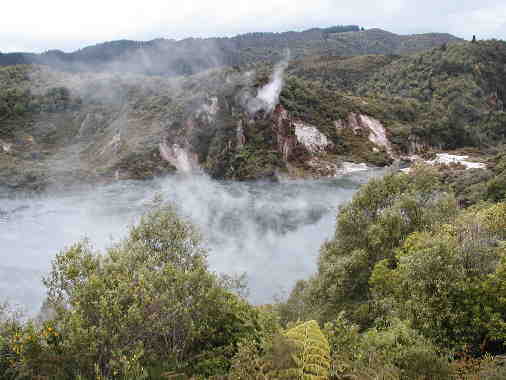
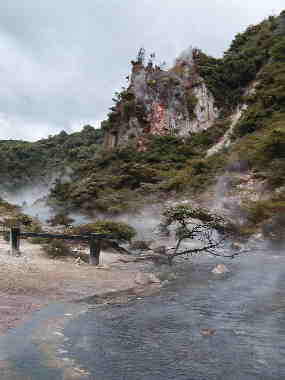
HAWKES BAY and CENTRAL NORTH ISLAND
20 November - 26 November
Remembering my promise not to bore you with a site by site account of our travels, we still wanted to share with you some of the highlights of our last week.
We drove south to Rotorua, a town pervaded by the smell of sulfur. Hot steam rises from vents in town parks and even from rain gutters by the roadside. On arrival we had a vigorous walk to the Blue-Green Lakes, both of which looked green to us. Green Lake is sacred to Maoris. During the walk we were afraid of violating some Maori tapu (origin of the word 'taboo').
Skipping the traditional Maori cultural tours at Rotorua, we checked in at the Polynesian Spa. Before the massage you are required to soak yourself in the hot outdoor mineral pools, so that you already come to the massage like a sponge. Eitan came out looking very happy after an excellent back massage. I had an AIX massage. While lying on the bed you have a massage with coconut oil while jets of hot water stream over your body. It certainly was a unique experience, but there were too many things going on to really concentrate on the massage and enjoy it – I was concerned about how the masseuse was doing, working with streams of water over her, worried about the cloth over my eyes getting too wet or when lying on my front having the ticklish sensation of my nose just lying in a puddle of water.
Our one disappointment was that Rotorua renowned for its trout fishing doesn't have trout on the menu. In fact you can't buy trout, neither in a shop nor a restaurant. If you catch a trout you can take it to a restaurant to cook it for you. We hadn't been fishing so we went to Poppy’s Villa, and enjoyed their award winning lamb and beef dishes.
The following morning we continued south and visited Waimangu Thermal Valley, formed in 1886 when Mt Tarawera erupted. A three star visit, combining a walk, bus ride and boat ride. We walked past Frying Pan Lake with steam/gas rising from the surface and delighted in a steaming stream winding between the kanuka bushes, a type of tea tree. It looked like a Japanese painting of a misty morning. It was wonderful.


Lindy and Richard flew down to Napier, where we met them. We spent afternoon in Napier – Art Deco buildings, more than in Miami Beach. Napier was destroyed in an earthquake in 1931 and then rebuilt in fashionable style of the day.
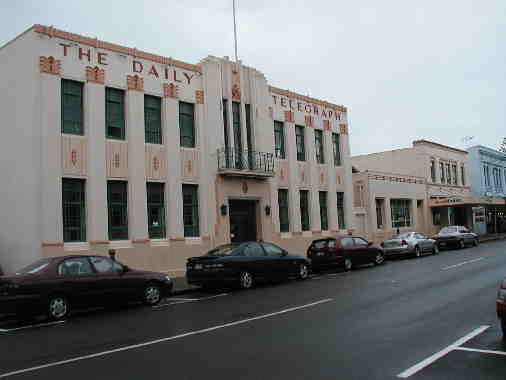
Then we started the wine tasting part of the tour. The Hawkes Bay area is an important wine producing area with over 30 wineries. We only managed to visit about ten and we must have tasted about 50 different wines - chardonnays, merlots, cab savs as referred to by New Zealanders who love to shorten everything. By Sunday we just managed to stuff some food down, but we were all out-wined by then (even though I had made liberal use of the wine spittoons!)
Lindy had booked us in at the Black Barn in Havelock North on the Lombardi Wine Estate. It is a wonderful two-bedroomed cottage with spacious kitchen, great lounge with fireplace – we needed it as the weather was cold and rainy all the time - and great views of the vineyards and hills in the distance. We went to the excellent local restaurants to savour their food and wine but Friday night dinner was spent at the cottage, enjoying a barbecue, excellent Coleraine wine, huge candles and sitting by the fire.
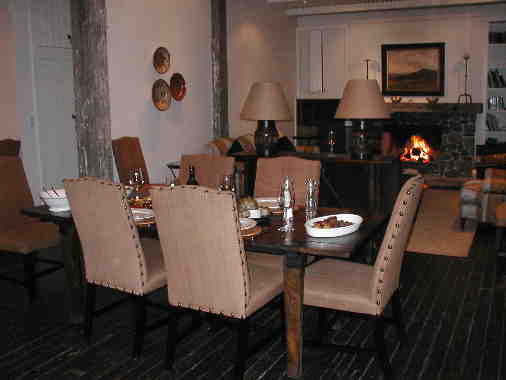
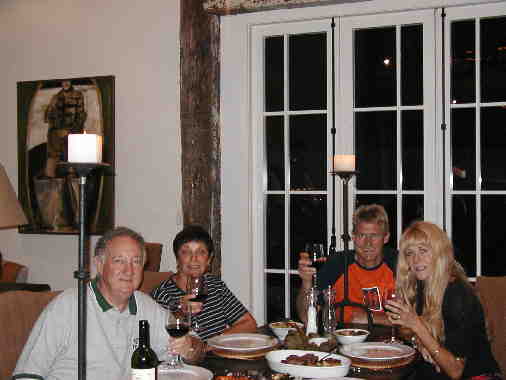
Monday 26 Nov Brilliant sunshine at last! Drove to Huka Falls by
Lake Taupo and then hiked along the Waikato River to the Aratiatia
Rapids. After 1-½ hours of walking, with a call on our cell
phone from Moran when we were in the middle of nowhere, we arrived at
rapids that were bare of water. To generate hydroelectric power the
sluice gates above the rapids are opened at predetermined times.
We watched fascinated as the water rushed down filling two pools before
the swirling water started to cascade down the rapids until they became
a raging torrent. It made the walk, 15 km return, worthwhile.
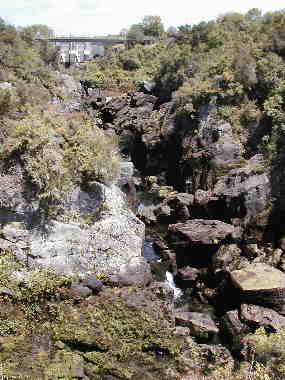
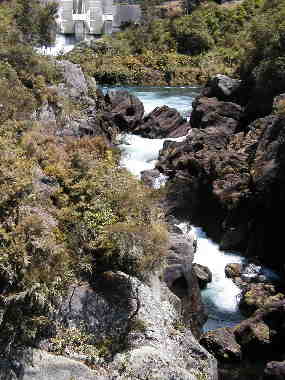
Drove to Waitoma and checked into Abseil Inn – perched on a steep hill; should have been named Abseil Downs. Had a surprisingly good dinner, with huge trucker portions at Caves Motor Inn. Dusk here goes on for hours – this half light period just hangs around for about 2 ½ hours until the light eventually fades. Just as it was finally getting dark, equipped with torches, we went for a bushwalk at Ruakuri, walking through natural tunnels in the limestone hills and alongside the dark vegetation with thousands of glowworms, like little elves’ lamps, glowing through the moist vegetation. An enchanting sight. Looking for a cup of coffee we arrived at the Waitoma Caves Hotel. Too late for coffee, but in the driveway we chatted to a man who was setting up his 5-inch computerized telescope. This was a little surprising as it was very cloudy, but the man wanted to show the manager of the hotel how the telescope worked. He had a lot of trouble because one of the wires kept on falling out. I felt very pleased to offer him my penknife to try and fix the loose connection, but that didn't work. Eitan looked and watched but said nothing. Eitan asked the man whether he had, by mistake, attached his computer cable to the telescope. The man looked so embarrassed that Eitan said that he too has made that mistake although he later confided that he only said it to make the guy feel better. The clouds cleared for a few seconds and we did get an excellent look at the craters on the moon, thanks to the hero of the hour..
Tuesday 27: Enjoyable breakfast at Abseil Inn with sheep farmers from Hawkes Bay area who had come to buy 1000 lambs to rear for meat. After breakfast we went blackwater rafting, an incredible experience. The weather was cold and grey but at Blackwater Rafting we got dressed in cold and wet 5mm wetsuits, booties and rubber boots and helmets with lamps. We drove to the same reserve that we had visited the night before. There we were fitted for inner tubes, that had to fit nicely over our bums - quite a job let me tell you. To check out if the size was right, we had to stand on a platform above the river, position the tubes over our backsides and then jump backwards down into the icy river - 10 degrees C. Once we passed this initiation test we climbed out of the water and then hiked up a hill carrying our tubes. We crawled into a cave and sat among the stalactites and stalagmites while our eyes adjusted to the darkness. Then for over an hour we walked, waded, squeezed ourselves under, floated, tubed, jumped and just sailed through the Ruakuri Caves, using our lamps or sometimes just floating in the dark. The water was very cold but we didn't care because it was so interesting. On the cave walls and roofs there are glowworms - that give off tiny points of light annd when it is dark they look like broad ribbons of the brightest stars in the sky. Glowworms are the larvae of a certain gnat. They produce a soft greenish light at the end of a thread that attracts insects. The insect gets stuck in the thread, get reeled in and eaten. After 6-9 months of the larval stage the adult gnat emerges, mates, lays eggs and dies within three days!
One of the most beautiful sites was seeing light at the end of the
tunnel, literally. It was all grey and wet and we approached it with
awe, like entering a new world.
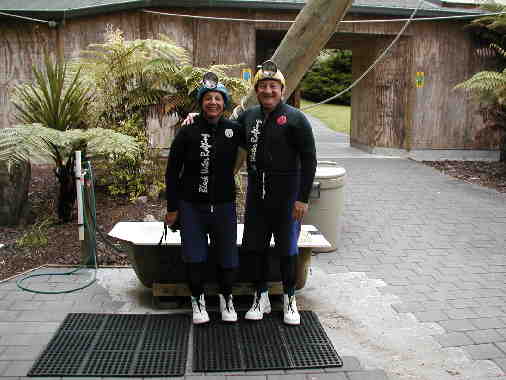
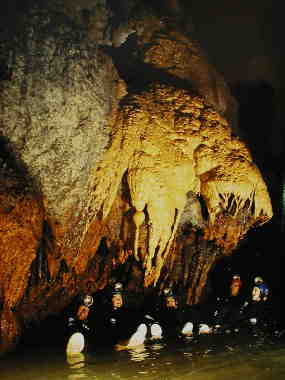
Then back to Auckland ( CLICK HERE ) ,
just in time to prepare for our trip to Fiji.